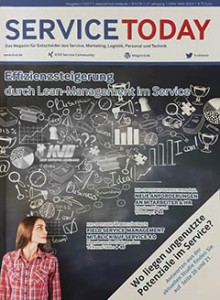
HOW INTERNAL SERVICE QUALITY IMPROVES THE PROCESSES WITHIN THE WHOLE ORGANISATION
Interview for the magazin; „wer liefert was“
August 2017

Efficiency increase of service with the help of Lean Management
Article in „Service Today“
01 / 2017, p. 42

Agiles Projektmanagsment:
SCRUM – Wie geht es? Was bringt es?
Report on Dr. Claudia Drews in „Technik in Bayern“
Output 02 / 2016, p. 29

LEAN MANAGEMENT 2.0 success FACTOR
Competitive streamlining in a sustainable and customer-driven manner. How can the lean philosophy gain a new quality?
- more
Production has learnt its lessons from the excessive pressure to cut costs demanded by the traditional understanding of the lean concept. Lean Management 2.0 no longer makes costs the key drivers for change, but customers. Because if structures and processes are repeatedly optimised without creating buffers and opportunities to pull plugs, quality suffers. The publisher of this book recommends that “less is more” because this is the only way of ensuring teams and structures are robust enough to satisfy customers fully. A variety of authors from companies, universities and the consultancy industry provide practical contributions to this success-factor book. Companies that want to set up, develop or enhance their lean management process, will find a rich variety of tried-and-tested ideas.

Performance management as a success factor
A motivated and enlightened generation
Nothing’s more constant than change. And it’s this stark reality that businesses know a thing or two about. Globalisation is demanding ever shorter periods of time and faster routes to adapt to new technologies, products and services.
- more
Other factors are well-informed customers. These people are extremely demanding, fully aware of prices due to the internet and prepared to use social media to praise products and services by liking them, or to air any grievances they might have as disappointed customers.
Managing these sorts of changes leads to confusion and disorientation. This applies above all when they happen too quickly, aren’t identified in time and any counteraction is taken too late. A lack of direction in terms of strategy and organisation is the result. This in turn upsets staff, customers and shareholders and causes a backlash. Because these stakeholders expect strong management that’s on top of organisational processes and creates the right stimuli at the right time.
Performance Management
Faced with these sorts of challenges, popular management control systems reach their limits. They frequently don’t get to the bottom of the real reasons for positive or negative developments in performance, but merely restrict themselves to displaying results. How and where does maximum performance in a company occur? The answer is: people! Companies with a motivated, talented workforce and management team that offer their customers first-class products and exceptional services are in excellent positions. Performance management is committed to constant improvement by creating a sense of team spirit, providing clear structures and information routes, feedback loops and fostering personal interaction that shows appreciation. The condition is bold management of people in the company that allows everyone to adopt their own personal approach by overcoming anxieties, establishing visions and fostering the desire to succeed. The goal is to offer staff and management the means to carry out their jobs independently and successfully. In other words, to provide an environment that young professionals, the so-called millennials, nowadays often don’t just expect but frequently assume.
Authors on the subject, from companies hailing from all sorts of different industries, from universities and from the consultancy sector, contribute to this reference guide by providing practical examples. From separate branches or integrated solutions, they give examples of success stories and suggest potential alternatives and approaches.

Success Factor Employer Branding
Binding employees and recruiting generation Y
Highly-qualified and motivated employees are an essential and increasingly scarce success factor for every company. Especially in view of the demographic shift.
- more
Revolution Y
Generation Y – also known as the net generation or digital natives – will radically change the employment world. This will result from both their familiarity with technology and their multitasking capabilities. They also have more demanding standards for the workplace. Career starters confront companies with high expectations regarding flexible working hours and career development.
In future individuality, opportunities for self-actualization along with the employer’s flexibility will be more important than security and bonuses. The job should be enjoyable and intellectually challenging. Generation Y has no tolerance for boredom. They expect creative tasks and the corresponding level of freedom to complete them. Even though major corporate brands are attractive, young talents regard classic corporate structures as slow and inefficient. If an employer is not appealing enough, this results in job hopping. Expert authors from companies, universities and the consulting sector along with representatives of generation Y make their practical contribution to this manual. It supports companies with creating, developing or optimizing their employer branding.

Success factor customer satisfaction
A roadmap rich in ideas and suggestions for integrated and sustainable optimization of customer satisfaction
- more

Customer satisfaction manual
The customer is king? Anything but! More of an annoyance or a source of complaints – At least that is the way they are often treated.
- more

From internal customer satisfaction
to external customer loyalty:
Uncompromising customer orientation as a success factor
- more

Managing internal customer-supplier relationships
The „Internal customer-supplier relationships“ management concept optimises business processes and aligns them with the needs of internal customers.
- more